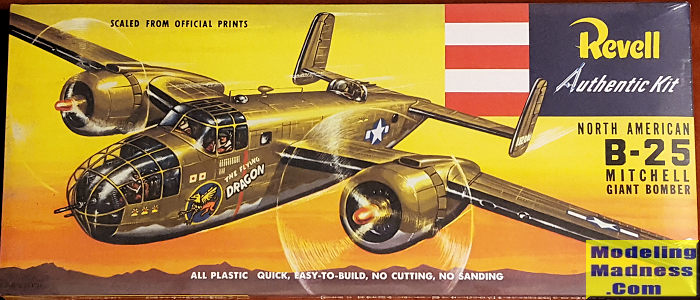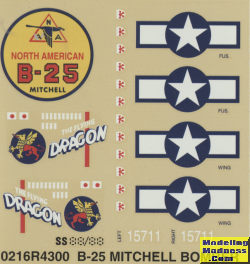Revell Box Scale B-25 Mitchell
|
KIT #: |
H-216 |
|
PRICE: |
$15.00 when new |
|
DECALS: |
One option |
|
REVIEWER: |
Scott Van Aken |
|
NOTES: |
1995 reissue of a 1954 kit |

The early B-25 was immortalized in the daring Doolittle
raid of April of 1942. If you are unaware of the event, I suggest looking it up.
That was performed with a B-25B, the first reliable production version of the
aircraft. It was actually built in fairly small numbers, before being superseded
by the B-25C/D version that was more combat capable. The only difference between
the C and D version was where it was built. It went on to be used in all
theaters of operation, but was particularly successful in the Southwest Pacific
once additional guns were added to the nose. This vastly improved its ability to
strike ground targets and to go after ships and smaller watercraft.
This particular kit was
initially released in 1954 and while it is somewhat crude compared to current
kit technology, it is a fairly accurate representation of an early B-25. It was
the norm in those days to design kits to fit into standard boxes and both Revell
and Monogram did so. The B-25 fit into the larger of two standard boxes, hence
the 'giant' appellation on the box art.
From
my understanding, it scales out to something like 1/64-67. Larger than 1/72, but
smaller than 1/48.
This kit is part of the resurgence of nostalgia kits that eventually became
known as the SSP line. The box is identical to that of the initial release, save
that there is a copyright date of 1995 on the outside of the box. This is in
such small lettering, that unscrupulous sellers were foisting this off as an
original until Revell started making it very obvious that it was a reissue.
So what were 1954 kits like? Well, all the crew members are molded into
their seats. The exterior surface detailing is raised and there are rivets,
though really, they are quite small. Canvas control surfaces have the standard
'hills and valleys' to represent fabric. Landing gear are simplified and the
wheels have huge holes in the center to plug into equally large axles so the
model can roll. Engine detail is molded into the cowlings and while rather
generic, isn't all that bad.
The kit has a lower turret that is in the extended
position. Both it and the upper turret are light on details and only have gun
shapes. One of the more unusual aspects of this is that all the framework for
the canopy and bombardier's nose is molded on the inside. While this makes for a
smooth exterior, masking
 the frames
will be difficult. I doubt if anyone does a masking set for this. Though it
isn't shown, the kit can be built wheels up simply by leaving off the landing
gear and gluing the doors closed. There is an original S-stand and it includes
the metal ring to hold the ball in place. This ball is installed on the bottom
of the fuselage, the slot for it already being opened.
the frames
will be difficult. I doubt if anyone does a masking set for this. Though it
isn't shown, the kit can be built wheels up simply by leaving off the landing
gear and gluing the doors closed. There is an original S-stand and it includes
the metal ring to hold the ball in place. This ball is installed on the bottom
of the fuselage, the slot for it already being opened.
Instructions are printed as the original and generic color information is
provided during the build. The decals are also like the original with the nice
decal for the display stand and inaccurate markings. Insignia are especially
poorly proportioned. There is no placement engraved on the parts, but it is
shown during the build.
Serious modelers will want
to stay away from this one, but it will make into a nice model with some work.
Part of that work will be filling some rather large sink areas on the wings,
fuselage and other large parts. The decals are thick and that sort of glossy
plastic look of the 80's and 90's. Despite being sealed, the backing has
yellowed. Still, this is a nostalgia build for anyone seeking to go for it. The
insignia and serials can be replaced if the kit markings prove to be too
horrible.
June 2018
Copyright ModelingMadness.com. All rights reserved.
If you would like your product reviewed fairly and fairly quickly, please
contact
the editor or see other details in the
Note to
Contributors.
Back to the Main Page
Back to the Review
Index Page
Back to the Previews Index Page


 the frames
will be difficult. I doubt if anyone does a masking set for this. Though it
isn't shown, the kit can be built wheels up simply by leaving off the landing
gear and gluing the doors closed. There is an original S-stand and it includes
the metal ring to hold the ball in place. This ball is installed on the bottom
of the fuselage, the slot for it already being opened.
the frames
will be difficult. I doubt if anyone does a masking set for this. Though it
isn't shown, the kit can be built wheels up simply by leaving off the landing
gear and gluing the doors closed. There is an original S-stand and it includes
the metal ring to hold the ball in place. This ball is installed on the bottom
of the fuselage, the slot for it already being opened.